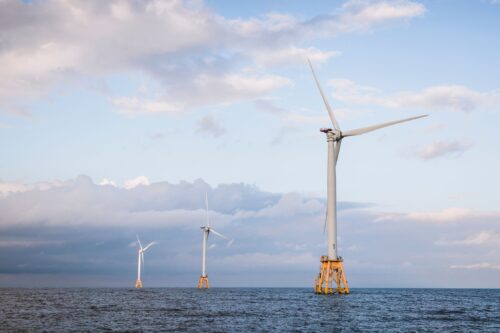
Canada has committed to reducing greenhouse gas emissions by 40–45% below 2005 levels by 2030 and reaching net-zero by 2050. Achieving these goals will require deep decarbonization across the energy system. In Atlantic Canada, the region’s strong offshore wind resources – among the best on the eastern seaboard – could play a meaningful role in this transition, particularly given the resource’s high output in the winter, when clean energy is needed most. Early development also offers an opportunity to leverage existing marine expertise and infrastructure. While this opportunity holds promise, offshore wind remains more expensive than alternative resource options today, and the region has no operating offshore wind projects today. Realizing offshore wind’s potential will require technology cost reductions and coordinated investment in transmission and integration planning.
To help chart a path forward, Net Zero Atlantic commissioned the Atlantic Canada Offshore Wind Grid Integration and Transmission Study, with funding from Natural Resources Canada. E3, as a subcontractor to Stantec, is leading the electricity system modeling and market analysis. The study is structured in three iterative phases. Phase 1, recently completed, involves an initial assessment of the long-term electricity demand scenarios and offshore wind offtake opportunities for domestic consumption, export, and hydrogen production. Phase 2 will refine offshore wind resource technical, locational, and economic potential, technology costs, and the operational and grid integration needs. Phase 3 will develop the final joint transmission and generation expansion portfolios, and incorporate more detailed transmission modeling to support the development of a final offshore wind roadmap.
Phase 1 uses the industry-leading electricity system capacity expansion model, PLEXOS-LT (developed by Energy Exemplar, with whom E3 maintains a strategic partnership), to assess how much offshore wind could be built to meet future demand from key potential offtake opportunities: domestic load growth, export markets, and green hydrogen production. The analysis evaluates a range of scenario-based offshore wind planning targets, from more limited build-outs to serve regional growth, to a deeply transformative future in which offshore wind supports a wide range of end uses, as shown in the figure below.

- Offshore wind can serve a significant share of regional electricity needs, particularly during winter periods. Electrification is expected to increase electricity demand in Atlantic Canada by nearly 30% by 2050. Coupled with near-term coal retirements and clean electricity mandates, this creates a need for new clean energy resources. Offshore wind’s seasonal generation profile aligns with winter demand peaks, when the grid is most stressed. Phase 1 scenarios modeled up to 2.5 GW of offshore wind supplying Atlantic Province needs by 2040. Additional modeling in Phase 2 will further quantify the impact on fossil fuel use and reliability.
- Atlantic offshore wind could also potentially serve export markets, particularly New England. Neighboring jurisdictions – including ISO-NE and central Canada – are pursuing net-zero targets and planning for significant new clean generation. Offshore wind from Atlantic Canada could help meet that demand given its high capacity factor and geographic proximity. Phase 1 modeled up to 6 GW of export-driven offshore wind by 2050. Realizing this opportunity will require substantial new transmission investment and cross-border coordination.
- Offshore wind could help supply a nascent hydrogen sector. While still uncertain, hydrogen presents a potential long-term opportunity for offshore wind offtake, especially if export-oriented production scales. Modeled scenarios included hydrogen demand ranging from 15 to 70+ TWh by 2050. Because of the uncertainty in hydrogen markets and technology costs, the analysis covers a broad range of demand trajectories, with future phases refining the assumptions.
- Cost reductions will be needed to make offshore wind competitive. Current capital costs for offshore wind are roughly double those of onshore wind, due to larger turbines, marine construction, and limited deployment experience in North America. While offshore wind offers higher energy output and stronger seasonal alignment, it remains a higher-cost option under present conditions. The Atlantic region has assets (including a skilled marine workforce and port infrastructure) that can support learning and cost declines. Still, future competitiveness will depend on policy support and the ability to scale effectively.
- Coordinated transmission investment is essential to integrate offshore wind at scale. The region’s existing interties are limited and often fully utilized. As offshore wind grows (particularly under export or hydrogen scenarios) transmission constraints lead to higher curtailment, which in turn reduces the value of generation. For example, in high offshore wind build scenarios with added withi-region and export transmission, curtailment reached nearly 15 TWh. Future phases will include more granular operational modeling to identify infrastructure and planning strategies that can minimize curtailment and improve system efficiency.
The Phase 1 report is available on Net Zero Atlantic’s website. Subsequent phases will refine wind resource characterization and evaluate operational grid integration to support a final roadmap for offshore wind development in Atlantic Canada.
This report was prepared by Liz Mettetal, Nathan Grady, Pedro de Vasconcellos Oporto, Ben Joseph, Chen Zhang, Riti Bhandarkar, Madeline Macmillan, Lakshmi Alagappan, and Arne Olson. Reach out to liz.mettetal@ethree.com with any questions.


